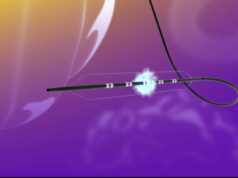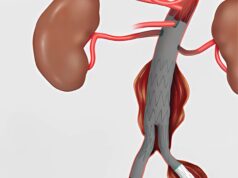
Controversies exist over the value of carotid stenting in patients at high risk for carotid endarterectomy (CEA) despite results of numerous trials and registries such as SAPPHIRE, ARCHeR as well as new data from the CABERNET and BEACH trialsKen Ouriel who presented the SAPPHIRE data at VEITHsymposium concluded that patients at high risk for CEA undergoing carotid stenting “do as well or better than those undergoing endarterectomy, repay the price of the procedure after about 5 years and have a life expectancy that exceeds the 5-year crossing point for this repayment.
Anthony Comerota from the Jobst Vascular Center in Toledo, Ohio who spoke after Ouriel disagreed that the benefit of carotid stenting has been proven.”Unquestionably, carotid artery angioplasty and stenting (CAS) is a procedure that is here to stay. Whether CAS benefits patients and whether it prevents stroke, remains to be shown”, said Anthony Comerota at the recent VEITHsymposium. “CEA is the most critically evaluated vascular surgical procedure. In prospective randomised trials, CEA has been proven to be superior to the best nonoperative management in both symptomatic and asymptomatic patients.1-6 Furthermore, CEA is the only treatment which has been proven to reduce the risk of stroke. The procedure-related risk of a neurologic deficit or death at 30 days (adjusted for disease-related risk of a similar event during the 30-day time period) is 1.2% for patients with a high-grade symptomatic carotid stenosis and 0.9% with asymptomatic disease. Recently, the MRC Asymptomatic Carotid Surgery Trialists reported similarly beneficial outcomes in patients with asymptomatic carotid artery stenosis treated with carotid endarterectomy. The above data must be put into proper perspective when evaluating new therapies, especially carotid artery angioplasty and stenting.”
Comerota looked carefully at the carotid stenting data to determine where the benefits lie regarding therapy for carotid bifurcation disease. “The underlying disease state must be considered (atherosclerosis versus neointimal fibroplasia) and whether the patient is symptomatic or not. The SAPPHIRE and ARCHeR data are frequently quoted as being supportive of carotid stenting. Unfortunately, both combine disease states and symptomatology. A comparison of procedure-related risk to the anticipated “lesion-related risk” should be the appropriate analysis.”
“The SAPPHIRE trial (patients at “high-risk” for carotid endarterectomy) data were presented to the FDA Circulatory System Devices Panel on April 21, 2004. An important but unresolved question was: “Were the patients at high risk for stroke?” Comerota is emphatic that they were not. “25% had recurrent carotid stenosis which is not atherosclerotic disease. 70% of the patients were asymptomatic. The overwhelming majority of patients did not have a high-grade stenosis by arteriogram. Less than 2% had a 90% stenosis or more and less than 20% had an 80% stenosis or more.”
The results of the randomised cohort demonstrated equivalence of CAS to CEA in terms of major adverse events, which included stroke, death and myocardial infarction. However, a significantly higher proportion of CAS patients had prior CABG and/or prior coronary angioplasty, biasing MI results, in favour of CAS. Comerota sees this as a bias to CAS. “Patients who undergo the case after coronary revascularisation have a much lower risk of MI and death. So there was a bias in favour of CAS at the outset. To further compound the bias all patients in the CAS arm were treated with clopidogrel but not for surgery. In order to put on an equal footing the surgical arm patients should have been put on clopidogrel two days after the operation to minimise the risk of bleeding.”
“Evaluating the 30-day outcome of all CAS patients, there was a 6.4% stroke/death/MI rate and a 5.4% stroke and death rate, in a group of patients, 70% of whom were asymptomatic. In the symptomatic patients, the 30-day stroke and death rate for all CAS patients was 5.8% whereas the 30-day stroke and death rate from best medical care would be approximately 0.9% (or probably less with today’s therapy such as statins, ACE inhibitors and more aggressive blood pressure targets.). In the CAS patients who were asymptomatic, the 30-day stroke and death rate was 5.4%, with an anticipated 0.4% if treated medically. These data demonstrate that the relative increased risk of CAS for stroke and death at 30-days compared to best medical treatment is approximately 640% for symptomatic patients and over 1,400% for asymptomatic patients. Since SAPPHIRE was designed specifically to compare CAS to patients at high risk of a poor outcome from CEA, there appears to be major inherent bias in choosing patients at high risk for intervention. However, there are no data showing that these patients were at high risk for stroke.
The ARCHeR data results from a registry of patients treated who are considered at high risk for CEA. Approximately 50% were asymptomatic and a high proportion was treated for recurrent carotid stenosis. Results showed a 30-day stroke/death/MI rate of 7.8% and a 30-day stroke/death rate of 6.6%. However, atherosclerotic patients suffered a 9.5% 30-day stroke/death rate and atherosclerotic dialysis patients suffered a 29% stroke/death rate at 30 days. Adjusting for the relative 30-day increased risk of stroke and death of atherosclerotic patients compared to best medical care, CAS had approximately a 1,400% relative increased risk.”
Comerota concludes that neither the SAPPHIRE nor the ARCHeR data support CAS on its own merits. “It is apparent that CEA should be discouraged in “high-risk” patients with carotid disease, as should CAS. This is especially true in patients with asymptomatic disease. CEA is the only procedure proven to reduce the risk of stroke. A trial evaluating CAS versus best medical care is mandatory, since the number of patients who will undergo CAS in the future will dwarf the number of patients ever treated by CEA.”












